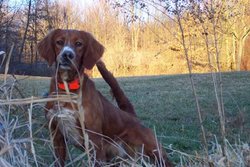
Irish Red Setter
|
From Wikipedia the free encyclopedia, by MultiMedia |
| Red Setter | |
|---|---|

Red Setter
|
|
| Alternative names | |
| Irish Setter Irish Red Setter |
|
| Country of origin | |
| Ireland | |
| Common nicknames | |
| Classification and breed standards | |
| FCI: | Group 7 Section 2 #120 |
| AKC: | Sporting |
| ANKC: | Group 3 (GunDogs) |
| CKC: | Group 1 - Sporting Dogs |
| KC (UK): | GunDog |
| NZKC: | GunDog |
| UKC: | Gun Dog Breeds |
| Not recognized by any major kennel club | |
| This breed of Dog is extinct | |
| Notes | |
The Red Setter is a variant of the Irish Setter or Irish Red Setter. The Red Setter is a pointing breed of Dog used to hunt upland game. Considerable acrimony exists between the partisans involved in the debate over this breed.
The Irish Setter was brought to the United States in the early 1800s. It commanded great respect in the field and was one of the most commonly used Dog among the professional meat hunter fraternity.
In 1874, the American Field put together the Field Dog Stud Book and registry of Dogs in the United States was born. At that time, Dogs could be registered even when bred from sires and dams of different breeds. At about this time, the Llewellin Setter was bred using blood lines from the Lavarack breeding of English Setter and, among other breeds, bloodlines from native Irish Setters. Around the same time, the red Irish Setter became a favorite in the Dog show ring.
The Irish Setter of the late 1800s was not just a red Dog. The AKC registered Irish Setters in a myriad of colors. Frank Forester, a 19th-century sports writer, described the Irish Setter as follows: "The points of the Irish Setter are more bony, angular, and wiry frame, a longer head, a less silky and straigher coat that those of the English. His color ought to be a deep orange-red and white, a common mark is a stripe of white between the eyes and a white ring around the neck, white stockings, and a white tage to the tail."
The Setter that was completely red, however, was preferred in the show ring and that is the direction that the breed took. Between 1874 and 1948, the breed produced 760 conformation champions, but only five field champions.
In the 1940s, Field and Stream magazine put into writing what was already a well-known fact. The Irish Setter was disappearing from the field and an outcross would be necessary to resurrect the breed as a working Dog. Sports Afield chimed in with a similar call for an outcross. Ned LaGrange of Pennsylvania spent a small fortune purchasing examples of the last of the working Irish Setters in America and importing Dogs from overseas. With the blessing of the Field Dog Stud Book, he began an outcross to red and white field champion English Setters. The National Red Setter Field Trial Club was created to test the Dogs and to encourage breeding toward a Dog that would successfully compete with the white setters. Thus the modern Red Setter was born and the controversy begun.
The American Kennel Club refused to recognize the Dogs registered by the Field Dog Stud Book in an unprecedented change. Until this time registration in one body automatically qualified a Dog for registration in the other. To this day, the policy of reciprocal registration between the AKC and the FDSB remains with all breeds except the Irish Red Setter.
The modern Red Setter is smaller than his bench-bred cousin. While show Dogs often reach 70 lbs, the working Red Setter is generally around 45 lbs. The coat is less silky and the feathering is generally shorter. The color is lighter, with the working Dog found in russet and fawn colors. The Red Setter often has patches of white on his face and chest as the Irish Setter of old did.
The Red Setter is a happy, biddable Dog. He is readily trainable and reportedly learns quickly. Most Red Setters do not retrieve as readily as many of the versatile breeds do but can be taught to retrieve to hand. The Red Setter makes a loving house companion and is reportedly good with children.
Dogs, made by MultiMedia | Free content and software
This guide is licensed under the GNU Free Documentation License. It uses material from the Wikipedia.